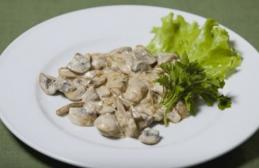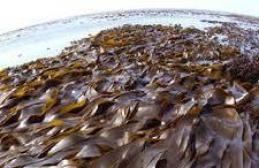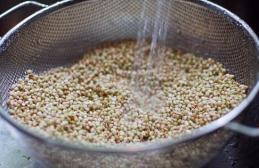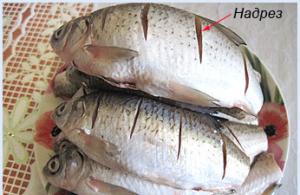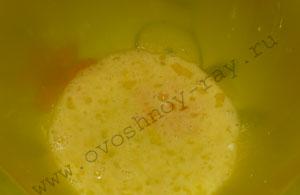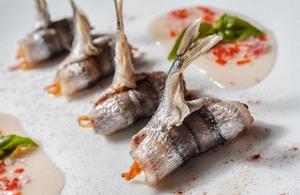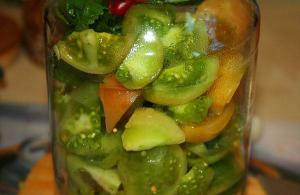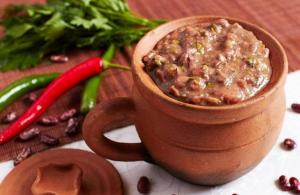The traditional method of pickling cabbage is simple. But until the cabbage is salted in its own juice, you need to wait several days. Quick salted cabbage will be ready in an hour. To prepare this simple and tasty snack you will need a simple brine. But first, prepare the vegetables.
You will need:
- 2 kg cabbage;
- 2 carrots;
- 5-6 cloves of garlic.
Finely chop the cabbage, cut the garlic into plastic pieces, grate the carrots using a Korean carrot grater or a regular coarse grater. To make the dish more elegant, you can cut the carrots into thin slices. If you wish, you can add 1 or 2 finely chopped sweet bell peppers to the salad. Quick salted cabbage with pepper it takes on an unusual piquancy.
Pickle forquick salted cabbage:
- 1 liter of water;
- 2 tbsp. l. with a heap of coarse salt;
- 100 g sugar;
- 200 g vegetable oil;
- 100 g table vinegar or 2 tbsp. l. vinegar essence.
Boil water, dissolve sugar and salt in it. Be sure to taste the brine - you may want to add salt. You can add allspice and bay leaves. When the brine is boiled, pour in the vinegar and remove from the heat. Add oil, stir and pour hot brine over the vegetables, previously placed in a 3-liter jar. Leave the cabbage at room temperature. When the jar has cooled, move it to the refrigerator.
After an hour, you can take the first sample. The cabbage should be crispy, salty and spicy. Ready quick salted cabbage Should be stored in the refrigerator for no longer than 2 weeks. To serve it, you don’t need to season it with anything, but you can add a little onion or fresh herbs. You can use this cabbage for vinaigrette and other dishes.
Quick salted cabbage This recipe will compete with traditional Korean salads. You can give it an oriental flavor if you add a tablespoon of ground coriander and red pepper to the brine to taste.
Salted cabbage without vinegar
As you can see, everything ingenious is simple, and you can pickle cabbage in just 20 minutes of work. If you don't want to use vinegar, omit it and oil from the recipe. The waiting time will have to be increased to 2 days, but you will receive traditional sauerkraut.
Our ancestors salted cabbage under oppression. The shredded cabbage was placed in a pan, sprinkled with grated carrots, salt, and dill seeds. An inverted plate was placed on top and a pressure (a jar of water) was placed on it. This will last for at least 2 days, but you can store it in the refrigerator almost until spring.
Did you know that sauerkraut contains 20 times more vitamin C than fresh cabbage? During the fermentation process in cabbage, like in kefir, a huge amount of probiotics is formed. Cabbage is healthy, tasty, can be stored for a long time, it can be eaten in the form of salads, stewed, prepared fillings for pies, and cooked cabbage soup. There are also many ways to pickle cabbage, thanks to which it turns out different and does not become boring.
Pickling cabbage is not difficult. But before you start preparing for the winter, it’s a good idea to familiarize yourself with some secrets and subtleties. They will help you avoid spoiling your vegetables and get crispy, juicy and aromatic cabbage.
Before you start cooking, watch this funny video.

If you have absolutely no experience in pickling cabbage, start with the simple method of pickling in pieces. There is no need to chop the cabbage for this salad. Vegetables are chopped coarsely, placed in glass jars and filled with marinade. Within a day the cabbage can be served. One drawback is that cabbage prepared according to this recipe cannot be stored for a long time. It must be eaten within 3-5 days. Then it peroxidizes and loses its taste and nutritional properties. Since cabbage cooks quickly, it is better to pickle a new batch after a while.
Recipe ingredients:
- cabbage 1 kg.
- carrots 1 pc.
- garlic 3-4 cloves
For the marinade:
- water 1 liter
- sugar ½ cup
- salt 2 tbsp. spoons
- vinegar 1 glass
- vegetable oil 1/2 cup
Cooking method:
- Wash the cabbage, remove a few top leaves, and cut into large pieces. Peel the carrots, cut into cubes or grate. Chop the garlic into slices; you can crush the small cloves with the side of a knife blade.
- Place the vegetables in a three-liter jar or enamel pan, layering the cabbage with pieces of carrots and garlic.
- Prepare the marinade. Mix water, sugar and salt. Stir until sugar and salt dissolve. Pour in vegetable oil. Bring the mixture to a boil, remove from heat and immediately pour in vinegar. Pour the hot marinade over the cabbage. Leave at room temperature for a day. Store in the refrigerator.
- Advice: Cabbage for pickling should be late or medium varieties with a dense plug. Usually, it is recommended to use large forks for pickling; they yield more finished product and less waste. For salting large pieces, not very large or even small forks are suitable. Cut them into 4-8 pieces into sectors along with the stalk.
Feeding method: Since the marinade contains vegetable oil, the cabbage does not need additional cooking. Remove the crispy pieces from the brine and serve.

To quickly prepare sauerkraut, marinade or brine is usually used. Vinegar is usually added to the marinade, which is not to everyone’s taste. We suggest trying a recipe for quick pickling of cabbage in jars without vinegar. It takes 2 days for cabbage to sour. After which it must be stored in the refrigerator.
Recipe ingredients:
- White cabbage 1 fork
- carrots 1 pc.
- peppercorns 10-15 pcs.
- bay leaf 3-5 pcs.
For the brine:
- water 1 l.
- salt 1 tbsp. spoon
- sugar 1/2 tbsp. spoons
Cooking method:
- Shred the cabbage. Grate the carrots on a coarse grater. The amount of carrots can be adjusted at your discretion. If you like light sauerkraut, reduce the amount of carrots. If you like the salad bright orange, add more orange vegetables. Please note that with a large amount of carrots, the salad will turn sour faster, so you need to eat it faster.
- Mix carrots and cabbage. Place tightly in a jar, topped with peppercorns and bay leaves.
- To prepare the brine, dissolve the required amount of sugar and salt in water. Pour brine over the cabbage. Place the jar in a deep bowl and leave to ferment at room temperature for 2 days. During the fermentation process, the amount of juice will increase, it may spill out of the jar, which is why the jar of cabbage should be placed in a deep bowl.
- After 2 days, close the jar with a lid and place in the refrigerator.
Feeding method: Before serving, add finely chopped onion, dill or parsley and vegetable oil to the cabbage.

Another simple and quick way to pickle large-cut cabbage is Georgian. Beetroot colors cabbage a delicate pink color and gives it a specific taste. The salad is ready in a day and can be stored in the refrigerator for no more than a week, so you shouldn’t prepare it in large batches for future use.
Recipe ingredients:
- cabbage 1.5 kg.
- carrots 100 g.
- beets 100 g.
- allspice 5-7 peas
- sugar 4 tbsp. spoons
- salt 3 tbsp. spoons
- vinegar 1 glass
- boiling water 2 liters
Cooking method:
- Cut the cabbage into checkers with a side of 3-4 centimeters. Cut carrots and beets into semicircles or cubes. Stir the vegetables and fill a three-liter jar tightly with them. Place allspice peas between the layers of cabbage. Pour salt and sugar into a jar, pour in vinegar and fill the jar to the top with boiling water.
- Leave to ferment at room temperature, placing a deep bowl or some container under the jar into which the juice released during fermentation will drain. After two days, close the jar with a nylon lid and put it in the refrigerator.
- Advice: Add 3-4 peeled and crushed garlic cloves to the jar. The cabbage will acquire a pleasant garlicky smell and piquant taste.

If you intend not only to diversify the table with a delicious cabbage salad, but to preserve the harvest and prepare real sauerkraut for the winter, you should work hard and be patient. Firstly, our grandmothers claim that tasty, juicy and crispy cabbage is obtained only if it is salted on the 5-6th day of the lunar calendar. Secondly, it is better to salt cabbage in large wooden tubs and store it in the cellar. In the absence of such, an enamel bucket, tank or plastic containers will do. Although experts say that the taste of such cabbage is somewhat different. Thirdly, prepare flavorings that give the cabbage a zest. These can be cumin or dill seeds, horseradish, oak bark, cranberries, lingonberries, apples, celery root, pepper.
Recipe ingredients:
- cabbage 10 kg.
- carrots 300 g.
- salt 200 g.
- cumin seeds 1/2 tbsp. spoons
- peppercorns 1/2 tbsp. spoons
- bay leaf 10 pcs.
- oak bark or grated horseradish root 1 teaspoon
Cooking method:
- Wash the cabbage, remove the top dense leaves, but do not throw away. Chop the cabbage finely using a sharp wide knife or grate it on a special grater. Don't try to chop it too thin if you want crispy cabbage. Grate the carrots on a coarse grater.
- Place shredded cabbage and carrots in a large bowl. Sprinkle with salt and rub with your hands, not too hard, until the juice appears. At the bottom of the pickling container, place some of the whole cabbage leaves removed from the forks at the beginning. Lay out a layer of cabbage and press it down with your fist or a masher until the juice comes out. Sprinkle with some cumin, oak bark, a few peppercorns and a bay leaf.
- Continue layering the cabbage, layering with spices, until you've laid it all out. Cover the top with the remaining whole cabbage leaves, place an inverted lid or plate, and place pressure. This can be an ordinary three-liter jar of water.
- The fermentation process takes 3-6 days at a temperature of 19-22°C. It all depends on the size of the container in which the cabbage is salted and the temperature. At low temperatures, the fermentation process is slowed down and stops altogether. At high temperatures it peroxidizes, becomes slippery and soft.
- If you did everything correctly, after a while juice and foam will appear on the surface of the tub. It needs to be removed. Every day the cabbage needs to be pierced to the very bottom with a wooden stick so that accumulated gases come to the surface. If this is not done, the cabbage will acquire an unpleasant bitter taste.
- On the third or fourth day, you will notice that there is less juice in the cabbage, and it seems to settle. This means that the fermentation process has come to an end. Taste the cabbage. If it seems that it lacks sourness, leave it warm for another day. After this, store in the refrigerator or cellar at a temperature of 0-5°C.
- Advice: The amount of salt, cabbage and carrots in this recipe has been tested for years, so we recommend that you weigh the products accurately and do not use your eye, then everything will definitely work out.
- Sauerkraut tolerates freezing well, without losing either taste or nutritional qualities. Place the finished cabbage in bags and freeze. Take it out as needed, defrost and eat with pleasure and benefit for the body.
It is not only tasty, but also a very healthy vegetable that is included in the diet of most people. You can prepare many delicious dishes from cabbage; it can also be consumed pickled, stewed, pickled, or raw. Cabbage juice is used in the treatment of many diseases. However, in our country the most popular dish made from this vegetable is sauerkraut. From this article you will learn how my grandmother prepares it correctly) and a lot of other useful information.
Beneficial features
It has been noticed that sauerkraut has an extremely positive effect on the human body, this is due to the fact that it contains many vitamins and microelements that help slow down the aging process and strengthen the immune system. In the process of preparing cabbage, fermented lactic bacteria are involved, which is why, after entering the intestines, it favors the improvement of the microflora. Sauerkraut (my grandmother’s recipe will be discussed below) brings iodine to the human body, without which internal organs and systems are not able to function normally. In addition, iodine normalizes blood sugar levels.
Compound
It was already mentioned above that sauerkraut contains a lot of C (its content in this product is the highest), as well as vitamins B 1, B 2, B 6, U and K. In addition, the beneficial properties of the vegetable depend on microelements, also necessary for the body person. These include: iodine, fluorine, molybdenum, manganese, chromium, copper, calcium, potassium, magnesium and sulfur.
Cooking options
Typically, sauerkraut (my grandmother's recipe) is prepared at home in several basic ways:
- Cabbage for pickling, chopped with a special shredder or knife.
- Finely chopped cabbage or hoe, pickled in a special wooden trough.
- Cabbage, chopped into halves or quarters.
The main ingredients for cooking are cabbage and salt, evenly distributed in it. Moreover, additives can be very different. These are bay leaves and carrots, apples and cranberries, dill seeds and caraway seeds, beets and much more. Thus, sauerkraut (my grandmother’s recipe) can be with any additives, it all depends on your preferences.
How to choose cabbage suitable for pickling
For pickling, you should choose late varieties. The forks that are chosen for harvesting for the winter should be white, with crispy and juicy leaves.

For starters, thrifty housewives choose large heads of cabbage. This is very advisable, as there is much less waste with a large fork compared to two small ones. During the preparation process, the upper leaves of the cabbage are cut off, which have a darker color with a greenish tint, rotten areas, any darkening, frostbitten or deformed. If you plan to pickle quarters or halves of a head of cabbage, then to ensure even salting, it is advisable to cut out the stalk.
We have come to the most basic question - how to sauerkraut correctly. We proceed from the fact that we need grandma’s classic. In this case, the following proportions are observed: 200 grams of salt per 10 kilograms of cabbage.

Cabbage can be fermented in a variety of ways, starting with the pickling option. This includes “wet” salting (the cabbage is compacted into a pre-prepared container and filled with brine) and dry salting (in this case, the cabbage is rubbed with dry salt by hand). In turn, wet salting can be done using hot and cold methods.
A traditional addition is carrots. However, even here the opinions of the housewives were divided. Some grate carrots on a coarse grater, while others prefer to cut them into long strips or thin slices. The only difference is that chopped carrots, compared to grated carrots, will not produce a large amount of juice. Thus, sauerkraut with chopped carrots will have a light, uncolored color.
Whole or sliced sour apples, cranberries, lingonberries and plums will also help diversify the taste. In addition, you can add mushrooms (salted or pickled), sweet bell peppers, celery and much more to sauerkraut.
Classic recipe
So, sauerkraut (grandmother’s recipe) is prepared as follows:

Sauerkraut: my grandmother’s recipe with photos
For preparation you will need the following ingredients:

For pickling, white and dense cabbage of late varieties is selected.
Salt is exclusively rock salt, not sea salt and not iodized, as iodine will make the cabbage limp and soft.
If desired, you can add spices - dried herbs, coriander, cumin.
You can salt in glass jars, a ceramic tub, or a saucepan. The dishes must be thoroughly washed, but not sterilized.
The number of products increases proportionally.
Step-by-step cooking recipe
So, sauerkraut, my grandmother’s recipe, involves the following sequence of actions:

Sauerkraut with beets: a recipe like my grandmother’s
Well-salted, crispy cabbage can be eaten the very next day. And most importantly, cabbage prepared according to this recipe will be stored for a very long time.
To prepare you will need:

- Beets, garlic and cabbage - the proportions are at your personal discretion.
For 1 liter of water there should be:
- 2 tbsp. spoons of salt;
- 2 pcs. bay leaf;
- 1 glass of 9% vinegar;
- 1 cup of sugar.
About 1.5 liters of this filling falls on a 3 liter jar.
Prepare pickled cabbage as follows:
- Cabbage is cut into arbitrary pieces or squares. The garlic should be left in whole cloves. The beets must be peeled and cut into slices.
- Packing it tightly, place the cabbage in the jar, topping it with garlic and beets.
- For the marinade, you need to boil water, dissolve sugar, salt in it and add bay leaf. Vinegar is poured into the boiling brine. As soon as the filling boils again, it needs to be poured into jars with cabbage and sealed.
- The jars should be left in a warm place until they cool completely, and then put in the refrigerator for storage.
Cabbage pickled for the winter, regardless of how it is done, is an excellent source of nutrients and vitamins throughout the cold winter. Although, as you understand, they eat it at other times, not only in winter. Who, having prepared sauerkraut (its second name), can resist leaving some for the coming days. There are many recipes for this tasty and healthy dish, but today we are interested in a quick, hot method.
Recipe No. 1: the simplest and fastest
Many housewives like the recipe for quick pickling described below. It does not require any special work or much time at all. And the result is the same excellent dish. That's why quick hot pickling of cabbage is such a popular method. So let's begin. Chop with a small fork, chop the garlic, grate the carrots. Add table vinegar, three or four tablespoons, and mix everything as best as possible. If desired, you can add dill (seeds).
All proportions are chosen to your own taste, which is why they are not listed here. Other recipes will have them. Prepare the brine: bring 130 ml of water to a boil, the same amount of sunflower oil, a spoonful of granulated sugar and salt, also add. Pour the brine over the cabbage, mix thoroughly. Be sure to try it and add more salt if necessary. Let it sit for an hour, then put it in the refrigerator. Another two hours, and quick hot pickling of cabbage is complete. You can eat.
Recipe No. 2: Provencal cabbage
Cabbage made according to this recipe will also be ready to eat in a few hours. We tell you another hot method of pickling cabbage. We take two kilograms of cabbage, chop it, grate two or three carrots on a coarse grater, cut three apples into large slices, add 150 grams of cranberries and prepare the brine. For the latter we will need: water - one liter, a glass of oil, olive or sunflower, salt - two tablespoons, ¾ glass of table vinegar, 250 grams of sugar, one head of garlic.

Place cabbage, carrots in layers in an enamel pan, then cranberries and apples, cabbage again and so on, repeating the layers. The top one is cabbage. After boiling the water with the prepared ingredients, prepare the brine and pour it into the pan, and put some kind of pressure on top. After several hours, a maximum of a day, “Provencal” is ready.
Recipe No. 3: traditional
Ingredients for the traditional pickling recipe: one kilogram of white cabbage, medium-sized carrots, vinegar (9%) - 250 ml, vegetable oil - the same amount, granulated sugar - nine tablespoons, coarse salt - four tablespoons, black pepper - ten peas, bay leaf - ten pieces, water - 500 ml. The hot method of salting cabbage using this method is very simple. We are preparing a large basin.

We clean and grate the carrots on a fine grater, and cut the washed cabbage into large pieces. Mix the vegetables in a bowl, sprinkle with bay leaves and pepper. Prepare a standard brine with sugar and salt, pour it into a bowl. Stir, cover with a lid or large plate, and let marinate for a day. You can leave it in the room. After a day, put it in washed jars, close it and put it in the refrigerator. To obtain a richer taste, let it sit in a basin for two or three days.
Recipe No. 4: cabbage with beets
Prepare the ingredients for ten servings: one head of firm cabbage, one or two boiled beets, one head of garlic, four pieces of bay leaf, allspice, a teaspoon of ground black pepper, two pieces of cloves, two tablespoons of salt (tablespoons), 250 grams of sugar, the same amount of 9% vinegar. Quick hot pickling of cabbage with beets, without chopping, is done like this. Cut half a fork of cabbage into several parts, disassemble it into pieces and put it in a jar in this form. Cook the beets for about half an hour. We wait until it cools down and cut it into squares, put it in layers with cabbage in a jar, and between them - garlic and bay leaf, compact it and make brine.

Boil two liters of clean water in a saucepan, salt it, add cloves, sugar and black peppercorns. Boil for five minutes, add vinegar. Cook the brine a little, but without boiling, fill the jars. We wait until it cools down and put it in the refrigerator. After 24 hours, the dish can be eaten.
Recipe No. 5: Cabbage with Garlic
Products for six servings: one kilogram of cabbage, two or three carrots, five cloves of garlic. For filling: sugar - 120 grams, coarse salt, half a liter of water, allspice and black pepper - four pieces each, 130 ml of vegetable oil and ten tablespoons of 9% vinegar. Finally, we’ll tell you how to quickly pickle cabbage using the hot method with garlic. Cut the cabbage into long and always thin strips.

Peel the carrots and grate them on a coarse grater. Pass the peeled garlic through a press and mix all the vegetables in a bowl. Cook the syrup as standard and pour it into the cabbage. Cover the container with a large plate on top and place a jar of water or other weight. Let it sit for four to five hours at room temperature. We transfer the finished sauerkraut into jars, close them with nylon lids, and put them in the refrigerator. Bon appetit!

